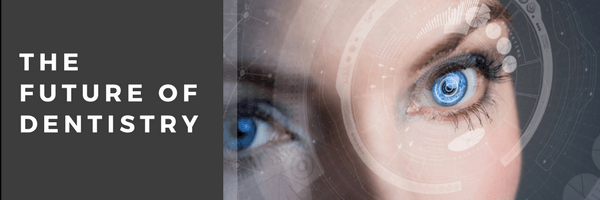Blog Layout
What the Future of Dentistry may hold
Admin • Jan 30, 2018
The future of dentistry may look very different than the practice of today.

Technological advances that are transforming every aspect of our world are also impacting dentistry in a multitude of ways, from prevention methods, diagnostic tools, and treatment options. Here’s a glimpse into the near and long-term possibilities of dental care:
Prevention
A myriad of dental care innovations focuses on prevention. Manufacturers are designing toothbrushes with cameras and location tracking technology that show you parts of your mouth you’re not brushing enough, pressure sensors that warn if you’re brushing too hard, timers that track how long you brush and apps that allow you to monitor your oral care.
Other innovators are attempting to create sensors that could detect various diseases from saliva or mouth tissue, could monitor heart rate, detect blood alcohol levels—or sense bad breath. For example, a mouthpiece outfitted with a pH sensor could detect acidic saliva—a risk factor for tooth decay and gum disease.
Diagnosis
The potential for dentists to provide more precise diagnosis and treatment will improve in the near future. Genome data could allow dental professionals to pinpoint an individual’s susceptibility to various types of oral disease. Dentists could tailor treatment to a patient’s genetics, making choices based on what is most effective for particular physiology. Treatment could even be based on the specific bacteria that are causing an oral health problem.
Diagnostic tools, like the “S-Ray,” may become available. This technology ultrasonically maps teeth and gums in 3-D to find cavities and disease. Upon approval from the U.S. Food and Drug Administration, experts think s-rays may be cheaper than x-rays. Furthermore, it doesn’t expose patients to radiation.
Treatment
Lasers are currently used by dental professionals in both diagnosis and treatment. Dentists use “soft tissue lasers” for minor gum surgery. In the future, “Hard-tissue lasers” could ultimately replace whining dental drills, removing tooth decay with the aid of tiny, digitally-controlled mirrors.
New breakthroughs are creating “biomaterials” to fill cavities. Harvard and the University of Nottingham have created a synthetic biomaterial that could allow a cavity to heal itself.
The future of dentistry could include nanobots that might restore or straighten teeth, deliver anesthesia during oral surgery, diagnose diabetes and other diseases, or treat oral cancer. Others may fight bacteria with products like “wearable toothpaste” made of antimicrobial carbon nanotubes.
Even with the most futuristic oral care, teeth will occasionally need to be replaced with a cap, crown or a bridge. Current technology uses Computer-Assisted Design/Computer-Assisted Manufacture (CAD/CAM) to mill a tooth from a 3-D scan. 3-D printing of crowns is becoming more common, and some researchers are working with recipes that could add tooth decay-fighting chemicals to 3-D printed teeth.
At Town & Country Dental, we are committed to staying on top of the latest technological developments in dental care. We are here to care for your teeth today, tomorrow and into the future.

